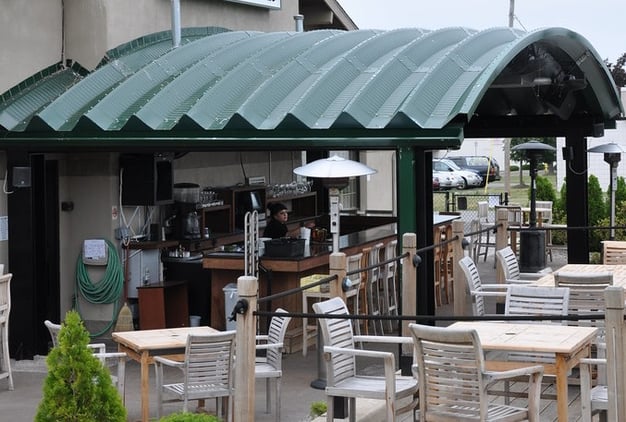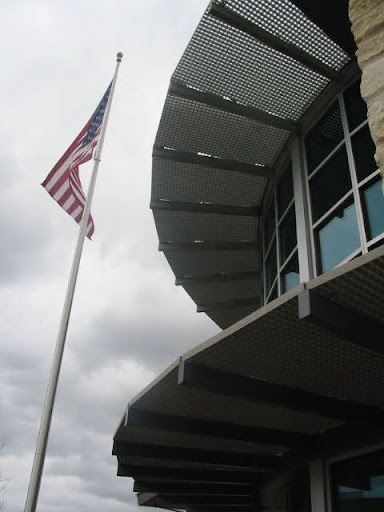When it comes to enhancing the aesthetics and functionality of commercial buildings, metal awnings...
Exploring Metal Awnings for Commercial Buildings
When it comes to enhancing the aesthetics and functionality of commercial buildings, metal awnings have always been popular. They can offer a range of potential benefits from energy efficiency to visual appeal. Read on as we explore the advantages of using metal awnings for commercial buildings, the various options available, and some potential challenges to consider.

This metal awning protects an outdoor bar at a restaurant |
Benefits of Having an Awning
- Energy Efficiency
Metal awnings can offer effective shading, reducing heat absorption within the building. This can lead to lower cooling costs during hot weather. - Weather Protection
They shield against rain, snow, and harmful UV rays - providing a more comfortable environment for both customers and employees. - Durability and Longevity
Metals, such as steel, copper, and aluminum, are known for durability when compared to fabric, ensuring that commercial awning stands the test of time; however, as we will explore later, fiberglass reinforced plastic awning materials potentially offer even more in terms of durability and longevity.
Popular Options for Metal Awnings
Like any construction project, materials matter when it comes to awnings. Choosing a metal awning for your design offers flexibility, allowing you to easily complement nearly any architectural theme seamlessly and with beautiful results. Some of the metal choices include:
- Steel: Its durability allows it to withstand harsh weather conditions including heavy winds and snow loads.
- Copper: As copper ages, it develops a beautiful patina that adds character and elegance to your commercial building.
- Aluminum: Aluminum may be an excellent option for those looking for a low-maintenance, cost-effective solution without compromising durability.
As you can see, different metals offer a range of options for commercial building owners, allowing you to select the one that best suits your specific needs and design preferences. Whether you prioritize strength, aesthetic transformation, or ease of maintenance, metal awnings provide a versatile way to enhance the appearance and functionality of your commercial space.
Customization and Personalization Options
- Tailoring to Fit: Metal awnings can be tailored to fit specific dimensions and shapes, ensuring a perfect fit for your commercial building.
- Color Palette and Finishes: Choose from a wide range of colors and finishes to seamlessly integrate your awning with the existing structure.
- Branding and Logos: For commercial applications, you can incorporate branding and logos into your metal awning to create a unique and recognizable identity.
Potential Challenges with Metal Awnings
- Rust and Corrosion:
Steel or iron awnings are susceptible to rust when exposed to moisture. Regular maintenance is essential to prevent this issue. Powder coating can help delay, but not entirely prevent, corrosion. - Fading and Discoloration
Metal awnings with painted finishes may fade over time due to UV exposure, requiring periodic repainting. - Bending and Warping
Heavy wind or impact can cause metal awnings to bend or warp, affecting both functionality and appearance. Hail may leave dents. - Loose or Damaged Fasteners
Regular inspections and maintenance are necessary to ensure that fasteners remain secure and undamaged. - Water Leakage
Proper design and installation are crucial to prevent water leakage issues which can damage the underlying structure. - Wind Noise
Metal awnings can generate noise during windy conditions, potentially causing disruptions. - Maintenance Challenges
Regular cleaning, repainting, and inspections are required to address these issues proactively. - Limited Design Options
Metal awnings may have limitations in design compared to other materials (or the metal may be expensive to customize) which may be a consideration for those seeking specific aesthetics. - Heat Absorption
Dark-colored metal awnings can absorb heat on sunny days and radiate it back out into what should be a cool, shady area. - Weight and Structural Load
Ensure that your building's structure can support the additional load of a metal awning without compromising its integrity.
Exploring Alternatives to Metal Awnings

The American Bank of Texas in Austin chose Fibergrate Molded Grating 4’ x 12’ Panels |
Depending on your business needs and the specific awning application, several materials may offer unique benefits over metal:
- Fiberglass Reinforced Plastic (FRP): Lightweight and versatile, FRP is corrosion resistant and can be coated to add to UV resistance, resulting in an exceptionally low maintenance awning structure.
- Canvas: Traditional and classic, canvas awnings can be treated to resist water and UV rays but may require more maintenance (while having a shorter life).
- Vinyl: Durable and low-maintenance, vinyl-coated fabrics come in various colors.
- Polyester: Lightweight, durable, and available in various patterns and colors.
- Acrylic: Vibrant colors and resistance to fading make acrylic fabrics a good choice for a balance between aesthetics and performance.
- Polycarbonate: Transparent or translucent, ideal for modern designs while providing rain protection.
- Wood: Provides a natural, rustic appearance but requires regular maintenance to prevent rot and decay.
Metal awnings for commercial buildings can pose potential challenges. We advocate for FRP as an alternative that is designed to outlast other materials, including metals. No matter which material you choose, a well-designed and maintained awning can greatly enhance the functionality and aesthetics of your commercial space. We would love the opportunity to hear about your awning project and help you decide if FRP is right for you. Reach out to the Fibergrate engineering team or your local sales consultant for help in evaluating your options.
Topics: FRP, Benefits, Corrosion Resistant, Architecture, architectural, shade structure, outdoor, uv resistance, awning


